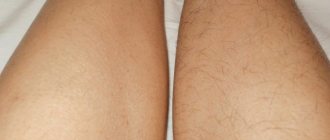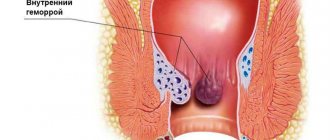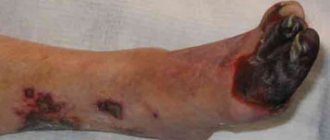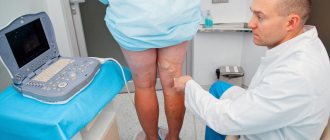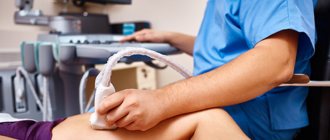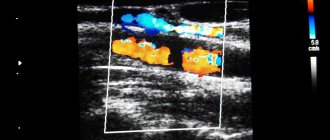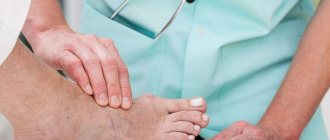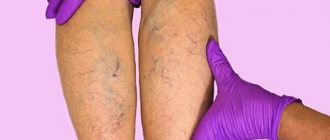Obliterating Atherosclerosis of the Vessels of the Lower Extremities (OALS) is a serious disease, the cause of which is the formation of atherosclerotic plaques on the internal walls of the arteries, leading to a narrowing of the lumen of the arteries up to complete blockage and disruption of blood flow in the lower extremities.
According to statistics, OASNK occurs in approximately 10% of men over 65 years of age.
In women, this disease is less common.
Historical fact : signs of atherosclerosis were discovered in ancient Egyptian mummies after CT scans, currently on display at the Museum of Antiquities in Cairo (Egypt).
22 mummies of people who died between the ages of 20 and 60. This means that the disease existed 3.5 thousand years ago. If it is impossible to remove the effect of provoking factors, if the treatment of OASNK is inadequate or ineffective, the prognosis is unfavorable: gangrene of the lower extremities develops, and in advanced cases, amputation is inevitable.
Factors contributing to the development of OASNK:
- bad habits - smoking, alcohol; - high blood pressure (BP); - high blood cholesterol levels; - obesity; - diabetes; - elderly age; - sedentary lifestyle; - stress; — presence of chronic infections; - treatment with estrogens; - a history of prolonged cooling and frostbite of the lower extremities at a young age; - burdened heredity.
Treatment of vascular atherosclerosis
Causes of atherosclerosis of the vessels of the lower extremities
Atherosclerosis is a fairly common disease that begins to affect a person after 40 years of age. But after 65, the development of obliterating atherosclerosis occurs much faster. Men suffer more from narrowing of the blood vessels in the legs - almost 80% of all cases.
Since atherosclerosis is a systemic disease, atherosclerosis obliterans is often only part of the problem. The vessels of the heart, brain, and kidneys are also subject to the destructive effects of this disease.
Factors influencing the development of the disease are:
- smoking
- stress
- excess weight
- sedentary lifestyle
- high cholesterol
- genetic predisposition
One of the main negative factors in the development of atherosclerosis of the lower extremities is smoking. Nicotine and tar increase the number of heartbeats and contribute to the development of plaques. Due to smoking, blood vessels become rougher, lose their elasticity and become thinner.
Smoking also causes high blood pressure. Atherosclerosis of the vessels of the extremities occurs twice as often in smokers as in non-smokers.
Excess weight is also associated with the development of the disease - poor nutrition and excess adipose tissue negatively affect blood vessels and the heart. In addition, excess weight, which leads to serious stress on the legs, increases the chances of developing obliterating atherosclerosis.
The sedentary lifestyle that many people lead also affects the process of vasoconstriction. Sedentary work and lack of adequate physical activity often lead to the development of the disease.
To avoid this, you need to exercise. This will not only improve blood circulation, but also keep you in shape.
Stressful situations and various worries do not have a direct effect on the occurrence of obliterating atherosclerosis, but are provoking factors.
Often, during nervous breakdowns and stress, people “eat up” or “wash down” their problems. Alcohol, fatty foods, smoking - all this leads to the development of not only atherosclerosis, but also to a whole bunch of other, no less serious diseases.
Hereditary diseases - hypertension, coronary heart disease, diabetes mellitus - are not the least important in the development of atherosclerosis. If your close relatives suffered from these diseases, and especially those aggravated by atherosclerosis, the likelihood of developing atherosclerosis increases sharply.
The existing unfavorable heredity should keep you on your guard - you need to monitor your health very carefully, lead a healthy lifestyle, eat right, and exercise. By eliminating additional negative factors, you can avoid the development of atherosclerosis.
Symptoms
The main symptom of this disease is intermittent claudication or peripheral ischemia syndrome.
This is an early but persistent symptom in OASNK. It consists in the fact that the patient notices severe pain in the joints and muscles of the legs when walking, and if the person stops the movement, the pain subsides. As you continue to move, the pain returns.
At night, the patient is bothered by cramps in the legs, numbness of the fingers, and there is a weak pulsation of the arteries of the lower extremities. If the slightest wounds appear on the skin of the legs, they heal slowly and often turn into trophic ulcers.
If the disease progresses, the pain in the extremities intensifies at night, becomes constant, burning, the skin on the legs is bluish and marbled. Subsequently, the skin on the legs becomes light purple with signs of necrosis.
In the later stages of the disease, patients cannot walk; they usually sit in bed with their legs down.
Pain in the legs increases with changing weather conditions.
An important diagnostic symptom for OASNK is the plantar symptom, which is performed as follows: without bending your legs at the knee joints, raise them 45 degrees and bend them at the ankle joints. Fatigue and pallor of the plantar surfaces of the feet indicate the degree of anemia of the tissues.
Preventive actions
As you can see, the treatment of this disease is quite a difficult, long and dangerous process. Medicines that really help can cause harm due to a large number of side effects. Therefore, you should be very careful and responsible about your health.
If you are examined on time and take the necessary tests, then you will not need long-term treatment. Be sure to reconsider your diet, because there are foods that help increase cholesterol, but at the same time, there are also those that lower it. Sufficient physical activity is required.
Some foods may help lower cholesterol
Many people think about a healthy lifestyle and proper nutrition, which is absolutely not in vain. After all, in the assortment of products that are found on the shelves, there are those that do nothing but harm. If we talk about cholesterol and its norm, which should not be exceeded, then the following foods should be excluded:
- chips;
- salted crackers;
- smoked meats;
- sausage;
- mayonnaise;
- ketchup;
- margarine;
- spread;
- alcohol;
- sparkling sweet water;
- sweet pastries;
- fatty food.
It is very important that the menu includes different foods that will saturate the body with vitamins. The following products are useful:
- carrot;
- tomatoes;
- garlic;
- pumpkin;
- cucumbers;
- zucchini;
- seafood.
Few people know, but ordinary raspberries, viburnum, and black rowan help lower cholesterol. In addition, rose hips, which have a lot of positive properties, cope well with this.
It is necessary to move enough and load yourself with physical activity. This does not necessarily mean playing sports in the gym; morning exercises and exercises before bed are enough.
Diagnosis for OASNK consists of:
1. Examination by a vascular surgeon with determination of pulsation of the main arteries of the lower extremities, listening to noise in the projection of large vessels, measuring blood pressure in the arms and legs using ultrasound Doppler.
2. Duplex scanning of arteries - ultrasound examination, which allows you to obtain a two-dimensional image of the vessels, assess their patency and the nature of blood flow through them.
3. X-ray contrast angiography – performed in cases of planning surgical treatment.
4. Spiral computed tomography or magnetic resonance imaging in vascular mode - SCT - angiography and MR angiography, when a contrast agent is injected into the saphenous vein of the arm.
There are other methods for diagnosing this pathology.
Recommendations for OASNK are as follows:
— Give up bad habits, especially smoking. The nicotine contained in tobacco causes the arteries to spasm (narrow), which leads to a deterioration in blood flow and an increased risk of blood clots in the vessels.
— Carry out weight correction (if you are overweight and especially if you are obese).
— Monitor blood pressure (no more than 140/90), blood sugar and cholesterol;
— Lead an active lifestyle. Do physical exercise - training walking, exercise on an exercise bike, swimming in the pool. To create an individual exercise program, consult a physical therapy (physical therapy) doctor. Physical exercise helps to increase the flow of oxygen to the muscles and the development of ollateral blood circulation in the extremities. Clinical observations show that if exercise is performed consistently, it reduces the symptoms of intermittent claudication and increases pain-free walking distance. The recommended set of exercises should be performed at least 3 times a week for 35-40 minutes.
— Drug treatment consists of the use of anticoagulants (blood thinners), antispasmodics, vasodilators, vitamin therapy, painkillers, antihistamines, homeopathy, etc., which are prescribed by the attending physician. Treatment depends on the stage of the disease and its extent. Therapeutic treatment is aimed at improving blood supply to the veins of the lower extremities and the entire body as a whole.
Among the physiotherapeutic interventions for OASNK are laser therapy with devices of the RIKTA series , magnetic therapy, UHF therapy, radon, hydrogen sulfide, dry carbon dioxide baths, hirudotherapy (leech treatment), balneotherapy (water procedures - underwater shower massage), ozone therapy, hyperbaric oxygenation, acupressure , gravity.
Physiotherapeutic treatment must be carried out at least 2 times a year. This gives long-term remission. Therefore, the use of laser therapy at home is of great importance, especially in patients who already have difficulty moving due to pain in the lower extremities.
Separately, it is worth highlighting the RIKTA-ESMIL 2A device, in which, along with laser exposure, there is an additional fifth factor - Transcutaneous Electrical Neurostimulation (TENS), which improves and restores neuromuscular regulation of the affected limbs.
Laser therapy for OASNK:
— helps eliminate vascular spasm by improving blood circulation;
- relieves pain, cramps, swelling and inflammation;
- saturates tissues with oxygen;
- prevents the development of complications;
- enhances the effect of drug therapy.
Diet for high cholesterol
To improve cholesterol balance in the body, it is important to eat right. The body should receive healthy foods and not harmful ones. They allow you to increase the proportion of high-density lipoproteins (“cleaners” of blood vessels) and reduce the proportion of low-density lipoproteins (atherogenic enemies). There are 3 classes of substances that must be present in the diet:
- Omega-3 polyunsaturated fatty acids, which are especially rich in fatty sea fish, avocados, and natural (unfried) vegetable oils.
- Hycosides – These can be found in grapefruit.
- Flavonoids contained in apples.
Now let's learn more about how to try to protect blood vessels using proper nutrition, and what you should include in your menu.
Avocado
This vegetable contains a lot of omega-3 acids, in particular eicosapentaenoic and decosahexoenoic acids. These substances prevent the negative effects of oxidative stress, which triggers the aging process. Omega-3 acids help neutralize free radicals that damage blood vessels. But it is precisely to the sites of damage that cholesterol molecules rush, trying to “patch up” the resulting holes. But instead of benefit, they only bring harm - over time, the cholesterol plaque can significantly increase in volume and lead to blockage of the feeding vessel.
In addition, avocados consumed as part of the diet are rich in potassium. By competing with calcium for binding sites, this mineral prevents the deposition of calcium salts, which make blood vessels fragile (elasticity decreases).
Fatty sea fish
This diet product is rich in unsaturated fatty acids, which are essential for the normal functioning of the heart and blood vessels. These are healthy fats from which “good” high-density lipoproteins are formed, which protect blood vessels. Sea fish contains a lot of protein and beneficial microelements, especially iodine. Optimal content of the latter is important for proper functioning of the thyroid gland. But it is thyroid hormones that determine metabolic activity. It is already a proven fact that hypothyroidism (decreased thyroid function) increases the risk of atherosclerosis. Therefore, to counter this disease, include fatty sea fish (salmon, trout, mackerel, capelin) in your menu at least 2 times a week to effectively prevent atherosclerosis.
Broccoli
Broccoli is a source of sulforapane. This substance directly prevents the formation of atherosclerotic plaques, so it must be present as part of a hypocholesterol diet.
In addition, broccoli contains a lot of coarse fiber. At the intestinal level it acts as a sorbent. Increasing in volume, it reduces the absorption of harmful substances, including excess cholesterol. In addition, it normalizes intestinal motility. This means that unnecessary metabolites from food have less time to contact the mucous membrane, so there is a greater likelihood that they will exit the body in transit.
Grapefruit
Grapefruit contains glycosides that have a positive effect on the heart muscle and the condition of the internal lining of blood vessels, thereby preventing the development of atherosclerosis. And the presence of vitamin P helps to further strengthen the vascular wall, increasing its resistance to damage. This complex effect, combined with a decrease in blood pressure, occurs with regular consumption of these citrus fruits.
However, you should be careful with grapefruit if you are already taking statins, a special class of drugs that are needed to lower high levels of “bad” cholesterol. These drugs are metabolized in the liver by a special enzyme system. And some substances in grapefruit can temporarily inactivate this enzyme, which increases the likelihood of side effects from taking statins. Therefore, ask your doctor in advance whether the metabolism of the drug changes when used simultaneously with grapefruit.
Apples
Apples are a real storehouse of flavonoids. They set cholesterol metabolism in the body in the right direction, reducing the risk of coronary heart disease and other cardiac pathologies. It is recommended to eat 2-3 apples a day. Don't forget about calories. If you are watching your weight, then as part of your diet you should choose sour or sweet and sour varieties.
Scheme of laser therapy for OASNK:
| № | Impact area | Frequency | Exposure (time) |
| 1 | Pulsation zone of the femoral artery. | 50 Hz | 2 minutes for each zone |
| 2 | Zones along the anterior-inner surface of the thigh and lower leg, with an interval between impact zones of about 10 cm. | ||
| 3 | Zones on both sides of the Achilles tendon. | ||
| 4 | Middle of the calf muscle. | ||
| 5 | Popliteal fossa. | ||
| 6 | Paravertebral effect on the lumbosacral region. | MOVE | 4 minutes on each side |
A course of laser therapy for OASNK consists of 15-20 daily procedures.
The procedures are carried out alternately: one day on the left leg, one day on the right leg.
Sessions are held every other day or daily.
Laser therapy courses are recommended to be carried out 3-4 times a year.
If necessary, on the recommendation of a doctor, 3 courses of laser therapy are carried out with an interval of 1 month according to the above scheme.
Surgical treatment is used in cases where conservative treatment is ineffective and the disease progresses. Common types of surgical treatment are bypass surgery, prosthetics, endarterectomy, stenting, balloon angioplasty and others.
